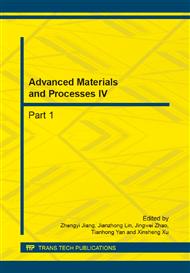p.642
p.647
p.654
p.659
p.665
p.671
p.675
p.679
p.684
Investigation of Femtosecond Laser Ablation Threshold for Nickel Template
Abstract:
This paper presents a theoretical and experimental investigation into the ablation threshold of nickel template by femtosecond laser in air at atmospheric pressure. The laser pulses used for the study are 800 nm in wavelength, 100fs in pulse duration, and 1KHz in repetition rate. The two-temperature model is used to predict the single-pulse ablation threshold for nickel theoretically. Micro-hole ablation experiments are carried out in air by focusing the femtosecond laser beam on the nickel target surface at normal incidence with the long-focus objective lens of enlargement factor 50 and NA=0.7 to determine the single-pulse and multi-pulse ablation thresholds for nickel by setting up the relationship between the measured hole diameters and the pulse energies. The single pulse ablation threshold of 4132.98 Jm-2 obtained experimentally is very close to that of 3907.99 Jm-2 predicted by two-temperature model. The incubation factor ξ, which describes the changes of the multi-pulse ablation thresholds with the number of pulses, is determined to be 0.812 for nickel.
Info:
Periodical:
Pages:
665-670
Citation:
Online since:
September 2014
Authors:
Keywords:
Price:
Сopyright:
© 2014 Trans Tech Publications Ltd. All Rights Reserved
Share:
Citation:


